JAWAHARLAL NEHRU SCIENCE CENTRE, MUMBAI
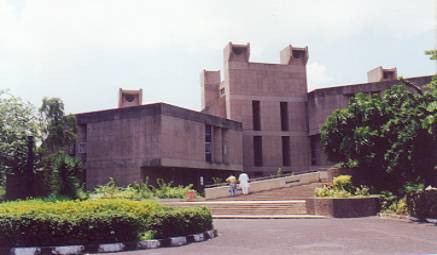
Contemporary museums are forms of open education and they have to meet
the growing demand for more information, more communication and thereby more
activity. One of the most fascinating contributions to the designing of scientific/technological
museums is the “workshop centre”. Rather than an awesome display of exhibits
with “do not touch” sign boards, and technical jargon, which offer nothing
in visual terms besides being a scientific encyclopaedia, the workshop concept
encourages public participation through visual demonstration. The Nehru Science
Centre in Mumbai, is one such workshop, which involves the visitor in a scientific
experience, giving him participative role in experiments, so that he/she no
longer remains a mere spectator. The centre has certain goals such as –
1.
To stimulate public awareness and interest in
science and technology.
2.
To co-operate with the education system in the
provision of an education facility for illustrating the cultural significance
relevant, and also the limitations of science and technology.
3.
To promote the dissemination of knowledge of science
and technology to all people with the co-operation of the scientific community
and industry.
4.
To act as a focus for scientific activities among
surrounding regions.
To sum up, the aim is to fulfil the receptivity of the mind and to create
a space with variation and interest. The main object during the design is
to arouse and stimulate interests of the human mind.
The Nehru Science Centre is located off E. Moses road, Worli, Mumbai.
The northern and western sides of the complex are surrounded be slums making
it impossible to link the structure with the planetarium on the western side.
The entire complex spreads across a sloped marshy land covering about 8 acres.
The general programme requires 13 acres of reclaimed land to accommodate
15,000 sq. m. of built up space, comprising of several functions related to
the museum.
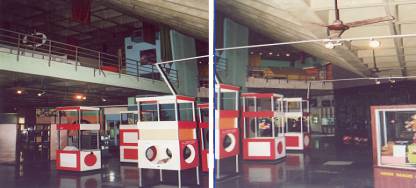
1.
Exposition without walls – children’s science
park with interactive exhibits of scientific phenomena, greenery and aviary.
2.
Exposition with walls – science for children,
sound and hearing and sight, discovery and our heritage.
3.
Educational extension counter – mini planetarium,
camp corners, creative ability centre, teachers’ training programmes, science
fair, seminars, quiz, ‘I m a mother’ shows, film shows, popular lectures and
many more.
Concept
The site is naturally sloping in different directions. The architect deliberately
wanted to maintain and accentuate to this natural topography of the site,
in the form of split-levels of modular units. The vast expanse of the metal
finish with grooves gives a more definite and dramatic character to the exterior.
Also the use of ventilation shafts has been commendably used to enhance the
character of the building.
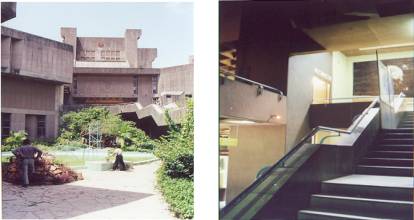
The entire complex has been built out with structure for functions like
the reception centre, the workshops, the museum and science park. The main
access road to the site bifurcates near this road. One of the bifurcations
leads to the museum building bypassing the science park and acting also as
a service road as it links the entrances to the temporary exhibition halls
and depositories to the main access road.
The children’s science park, the first ever in the country, was a gift
to the children of Mumbai from NCSM in 1979, the international year for children.
It is a science centre without walls. Large and sturdy exhibits covering various
fields of science and technology are interspersed with colourful landscape
to present a unique playground where education through fun is followed. The
science park is spread over an area of 4 hectares of land. It has various
transportation relics and scientific exhibits. The park is designed thoughtfully
with natural and artificial shades and resting places. Even though the total
distance from the main gate to the museum building is about 350m, the walk
is not found long and tiring because of the pathway leading through a beautifully
laid out science park. The park houses a sundial and a sand hour glass which
are the time markers, while the birds, animals, fish, water, plants, flowers,
green lawn and trees represent nature. A series of inclined planes, pulleys
and gears for easing man’s efforts in doing work, turn tables to watch action
and reaction, underground speaking tubes for sound transmission, water wheels,
Archimedes screw, a combination of colour filters revealing a colourful landscape
and many more make science more meaningful to the human mind. The objects
of historical importance such as horse drawn tramcar, electric tramcar, locomotives
etc. and beautifully shaped water bodies, animal cages and aviaries contribute
to make the science park different then the amusement park.
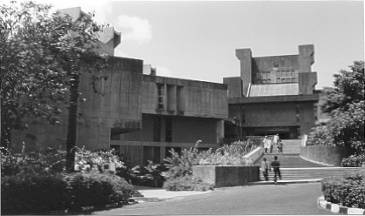
It is a small attractive structure placed near the parking lot, which
was initially designed to receive and guide visitors to the museum. But later
it was converted into an administrative area. Similar to the museum the plan
is evolved from a ‘Greek cross’. The central part of the structure for the
sunlight and the raised part is coupled with 4 sloping roofs for the 4 arms
of the cross. The reception centre consists of area such as – 4 cabins for
the directors of NSC, NCSM, technical officer and administrative officer,
meeting rooms and the general office.
Workshops
These are located near the entrance presently in temporary structures.
There are 3 main sections – fabrication, assembly and arts.
Fabrication and Assembly Workshop – these
functions are done in a small hall. It consists of various light machines
like lathe machine, bund saw, sheet metal binder, bench drill etc. All the
exhibits are fabricated in this section and then sent for assembling where
the fitters and turners put together the fabricated material and send for
painting.
Arts Workshop – this section consists of artist’s studios and
cabins for staff and general area for designers and artists.
It is situated on the western
side of the plot and composed of blocks A, B, C and D. the sloping nature
of the site has considerably influenced the design of the blocks (providing
split levels in the exhibition halls). The number of window openings has to
be reduced to have maximum wall surface for the exhibits. Hence artificial
ventilation becomes important. Wide shafts had to be used for this purpose
forming an integral part of the design.
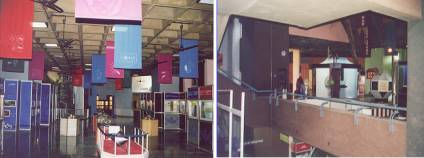
Structural System
As the site is reclaimed,
since it was a marshy land, pile foundation had to be used. The structural
system is conceived with structural supports placed at 12.0m c/c. These supports
are made up of hollow 2.3mX2.15m L.C. concrete tube which functions both as
structural components and conceal the air distribution system and the services.
Large unobstructed spans were essential for the exhibition halls of the science
centre. Therefore ribbed or waffle slab is used. The floor slab consists of
0.9mX0.9m fabricated or pre-cast R.C.C. waffle units.
Materials
The exterior surface of
the structure, for low maintenance cost, is finished with local grey stone,
grit plaster with grey cement (1:1) panels created by making grooves on the
grit plaster at certain intervals. The finish, although good in appearance
has certain disadvantages, such as –
1.
The grooves left between the panels are not watertight
and are a cause of heavy leakage during the monsoon.
2.
Rich mixture of cement has been used to cast large
panels which have cracked due to expansion and contraction. Even these cracks
are the cause of monsoon leakage.
3.
The grit plaster used does not hold on R.C.C.
surface therefore patches of shot-crete fallen from a few places spoiling
the elevation.
External Form
The building looks interesting
when viewed from all the angles. It creates a sense of curiosity and mystery
in the minds of the visitors. The science museum with its immense proportions
and massing does not overpower the visitor’s senses. The shot-crete used gives
a rugged and stark look to the structure; vertical and horizontal grooves
are introduced. The building has few windows minimising the elevational features
and shafts have been skilfully used to add interest to the elevation and have
served in animating the skyline.
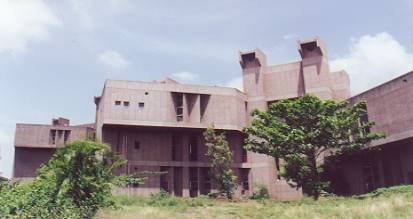
In popular Imagination science museums, there are either recycled historical
edifices with large halls, arched doorways and ordinate structures, devoid
of symbolic prominence. But the design of Nehru Science Centre is far removed
from this. Its design is basically modular, but the repetition of modules
does not become predictable. The module is evolved through a stage-by-stage
dissection process. Beginning with criss-cross modules, these are centrally
dissected to form a set of ‘Ls’ abutting one another. The form further develops
into a multi-directional module with central service cores and structural
shafts.
The main access to the
structure is through a flight of shallow steps with an ascending stepped bridge
which opens into a spacious podium on the first floor level of block B, instead
of the conventional pattern of entering the structure at ground level.
Block A
This block houses the administrative
and technical staff and the permanent office. Block A is connected to the
first floor and ground floor level to block B.
Block B
The main entrance of the
museum is a three-storey structure consisting of two hexagons connected by
a rectangular staircase block. Each hexagon forms a display area of 500 sq.
m. The first floor of this block houses the central hall and the hall of science.
As one enters the entrance hall from the open air podium one sees a massive
exhibit based on the principles of conservation of energy. Behind this exhibit
is the main staircase leading to the other exhibition halls. On the right
hand side of the entrance is the reception along with the souvenir shop and
the waiting area. On the split level 1.3m higher than the entrance hall is
the ‘Fun Science’ gallery housing interesting exhibits. Halls on the second
floor are devoted to ‘Light and Sight’ and ‘Sound and Hearing’ exhibits. The
third floor comprises of the ‘Discovery Hall’ and the computer section. The
Discovery hall is connected by a passage to ‘The Hall of Nature’ in block
C. these passages connecting different blocks are in the form of fully glazed
corridors. On the ground floor of block B is the cafeteria and temporary exhibition
gallery. The basement houses services such as the depository, kitchen and
storage for the science museum.
Block C
It is similar to block
B and comprises of various display areas such as ‘Hall of Industries’ and
the ‘C.V. Raman’ hall on the ground floor. ‘Evolution’ and ‘Heritage’ on the
first floor, ‘Heritage’ and Activities Hall on the second floor and the hall
of Nature on the third floor.
It houses the auditorium,
library and conference hall. It has an independent access, which leads to
a common entrance for both the library and the auditorium. The entrance doors
are very narrow and at 45 degree angle causing great inconvenience to the
visitors.
Circulation
The circulation pattern
broadly falls under two basic needs – the movement of people and that of the
exhibits. Visitors enter the main hall on the first floor level of the B block
through a flight of steps leading from the landscaped forecourt. From the
main hall they are gradually routed through the exhibition area. The circulation
route directs the public to the second floor from where they ascend viewing
the exhibits. Through the central staircase in block B one ascends to the
Discovery Hall. From here one moves on to block C reaching the Hall of Nature.
The visitor then starts to descend in this block, passing through the Hall
of Industries and Heritage Hall to reach the ground floor level to the temporary
exhibition halls. After exploring them, the visitor comes to the café lobby.
One climbs up to the entrance hall to exit from the stepped bridge.
Material circulation is
a very important aspect of museum design, which is organised by bringing the
material to be stored to the depository in the basement by a vehicular ramp.
The materials used in fabrication are sent to the workshop. Material movement
in the exhibition area is through a large freight lift in the central zone.
Supplies to the kitchen are also routed through the basement receiving space.
Interiors
The number of exhibition
halls, at various levels, is connected by staircase blocks with illuminated
by skylights and other fully glazed passageways. But each exhibition hall
with its massive area of 500 sq. m. coupled with a height of 4.0m projects
an overwhelming effect on the young visitor. The use of minimum number of
windows has given way to large display areas on the walls. This effect of
a large volume is brought down by hanging colourful banners from the ceiling,
though at some places it has been controlled and regulated by stepping the
roof slabs. The split-levels used to maintain the natural topography of the
site has helped in achieving an effect of spatial organisation and physical
as well as visual division of large spaces. The colour schemes of the exhibition
hall interiors consists of bright primary colours used particularly to attract
children and initiate them to the use of exhibits. The colour of the ceiling
is darkened so that no attention is drawn towards it.
Services
One of the most outstanding
features of the Nehru Science Centre is the efficiency with which their services
have been carried out. The toilet block is placed on the rear side in such
a way that all the pipes are concealed within the shaft. The water tank has
been suitably hidden between the tops of the ventilation shafts. The restrictions
on the number of windows in the exhibition halls has affected cross-ventilation.
Thus forced ventilation became necessary and it was preferred because the
other alternative of air-conditioning the building was very expensive.
The ventilation system
is purely mechanical. The centrifugal fans blow the air in through the vent
shafts and the tube-axial fans provided at the exhaust. Two blowers have been
fitted at the terrace level. These blowers are actually backward curved centrifugal
fans with double width and double inlet. These blowers suck the surrounding
air through the R.C.C. louvers and force it down the galvanised iron duct
in to the ventilation shafts. The shaft is a hollow tube measuring 2.3mX2.15m.
The forced air is thrown in to each display area through an inlet at the roof
level. The polluted air is thrown out from the exhibition areas through an
outlet at the floor level by means of tube axial fans mounted on top of each
shaft. The ventilation system has the following disadvantages –
1.
The amount of air changes facilitated by the system
does not achieve comfort levels.
2.
When forced air reaches the louver level the force
exerted by the blowers on the air is considerably reduced. Thus one does not
feel the fast air movement, which is necessary in a humid place like Bombay.
3.
The air inlets and outlets are placed just ten
feet away from each other.
4.
Loud noise and vibrations are caused by the blowers
inspite of the use of glass fibre lining on the ducts.
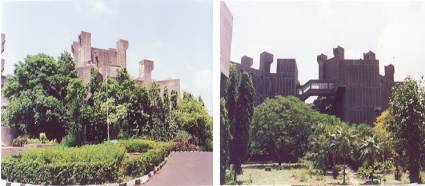
|
Spaces
|
Area (sq. m.)
|
|
| Administrative block | Entrance hall |
30
|
| General staff |
110
|
|
| Meeting room |
25
|
|
| Technical officer |
12
|
|
| Director's office |
35
|
|
| Administrative office |
30
|
|
| Toilets |
20
|
|
| Store |
20
|
|
| Temporary workshop | Fabrication room |
240
|
| Assembly hall |
270
|
|
| Cabins (4 nos.) |
40 each
|
|
| Residential accomodation | Staff (6 nos.) |
50 each
|
| Visitors (10 nos.) |
12.5 each
|
|
| Ladies' dormitory |
70
|
|
| Gents' dormitory |
100
|
|
| Security booth (3 nos.) |
10 each
|
|
| Snack counter (35 people) |
100
|
|
| Visitors' toilets |
150
|
|
| Science museum | Entrance podium |
40
|
| Entrance lobby |
350
|
|
| Ticket booth |
15
|
|
| Science hall | Science for children |
500
|
| Evolution |
500
|
|
| Vintage car |
500
|
|
| Display halls | Light and Sight |
300
|
| Sound and Hearing |
500
|
|
| Hall of Industries |
500
|
|
| Raman's achievements |
300
|
|
| Our Heritage I and II |
300
|
|
| Hall of Activities I (Discovery) |
300
|
|
| Hall of Activities II (Nature) |
300
|
|
| Auditorium | Entrance hall |
125
|
| Sitting for 250 |
300
|
|
| Projection room |
12
|
|
| Stage and store |
65
|
|
| Library |
270
|
|
| Conference room |
30
|
|
| Cafeteria |
150
|
|
| Kitchenette and pantry |
50
|
Total built-up area = 6291 sq. m.
Total plot area = 32,376 sq. m.
Therefore ratio = 1:5
GO TO PAGE-TOP